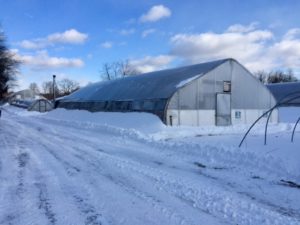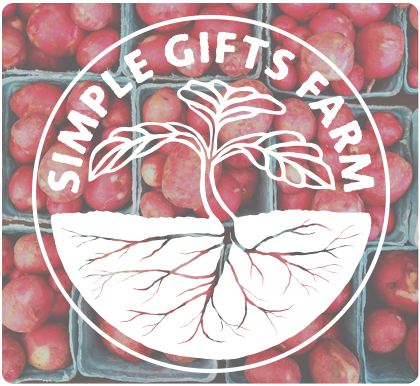
We seem to be at the end of this winter’s early cold snap, but it has been a doozy. The cold weather makes everything harder for us. Any time a hose gets used, all of the water must be drained out of it, or else it will turn into one long ice-pop. Even a little bit of water can cause a blockage, and then the hose has to be brought back to the greenhouse to thaw. Dave and Gabe spent three days trying to get our diesel tractor to start during the worst of it; that tractor is used less in the winter then it is during the growning season, but we rely on it to plow out our roads and parking lot, and to bring big round bales of hay to the cows. Diesel, as you may know, ignites in engines without a spark plug, relying on the temperature dynamics that result from pressurizing the combustible gas in the piston, so when the piston and the fuel are cold, it just doesn’t work. It turns out that the electric heating element that can be plugged in at night to keep the engine warm wasn’t working, but it took an extended trouble-shooting process to figure that out.
Most of our root crop storages are insulated boxes that rely on the fact that root crops actually produce heat (they are alive and respiring, and the key to long storage life is to keep them cold so that they respire as little as possible). In our learning process with root crop storage, we discovered that even on normally cold winter days, we need to keep the refrigeration on because the storage container will rise up into the 40s without refrigeration. Well, that wasn’t the case in this most recent cold snap. The “Ben and Jerry’s,” our used truck-body storage unit, got down to 27 in the week between Christmas and New Year’s, and the carrots, beets, celeriac, and rutabaga in there froze up. We put a little electric heater in there, and fortunately, they all seem to still be able to take a quick little freeze. The one real storage loss to the cold is our leeks. We usually put leeks into a unconditioned storage container and let them freeze and then thaw them out as we are ready to use them. As it turns out, there are degrees of freezing, and this year’s leeks went down to too low a degree of freezing; as we thaw them out, they turn into limp leek noodles. For now, we are out of leeks, but we’ll be keeping our eyes out for another farm that had better luck with storing theirs.
The scene in our greenhouses is that we are eking things out, but still have some stuff for you. December and January are the months when the days are the shortest, so we always have a short supply of greens this time of year. We have cold-hardy crops in unheated spaces, and less-hardy stuff in the heated houses. The baby kale, spinach, and miner’s lettuce in the unheated houses is all surviving but not thriving, which is what we expect from it this time of year. And the lettuce, arugula, chard, and bok choy in our heated houses are mostly performing as expected, but we burned some extra fuel to keep them at their just-above freezing-temperature. The heater in one of those houses quit working on us, so we have a tighter supply of those greens for the next few weeks until the days go past 10 hours of sunlight in February and things start going again. One thing that we have discovered this year is that we have a nice group of mild brassica-family greens that grow back much faster than lettuce in the short days in the heated spaces; we’ll be growing more of those next winter, but for now, look for the tender colorful greens we’ve got labelled as “salad mix” (next week; they’re still growing back from the last harvest).


Congrats on managing all these different spaces, crops, needs — wow! There’s always more to learn. Glad the roots were able to recover! My little cold room in our basement also got down too low (the little window was left open too long), and the carrots were frosty, but able to recover. Your salad and spinach greens have been terrific and the little heads of lettuce that were in the share last week are beautiful. I have been taking the freeze softened kale and it still keeps well and turns bright green when its steamed and tastes great. Sad to see that caterpillar come off in the big wind yesterday, leaving its kale exposed. It happened so fast!! Its the thaws that make temporary tunnels fall apart. So be it.
Look out your window, now, Ruth! We took the opportunity provided by the cover blowing off of that caterpillar to put the right plastic on! When we went to cover the tunnels the first time this fall, we discovered that they had sent the wrong plastic and decided to use the old, short piece of plastic just to get something on there. We got some lemonade out of that lemon, though really hot chocolate sounds a lot better right now.